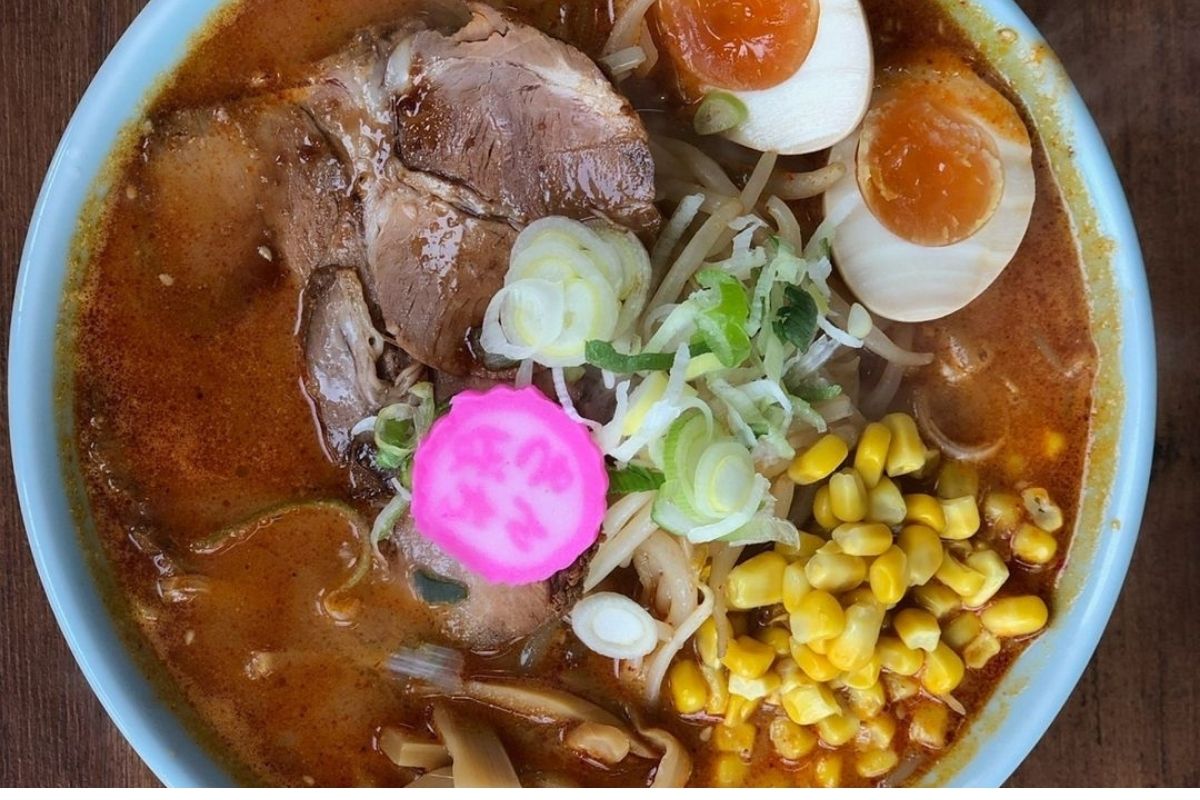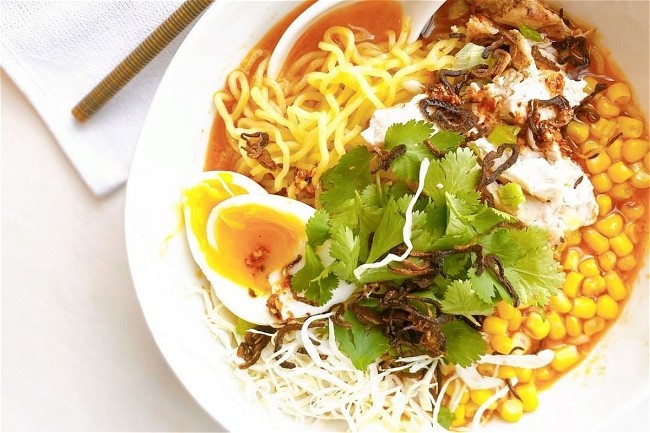Blog
What Is Miso Ramen? Everything To Know + An Easy Recipe

Miso ramen is a Japanese noodle soup. It is called Miso Ramen because its broth is made from miso along with chicken stock, vegetables, and ground pork. This kind of ramen soup is thick and rich. The noodles should be fresh and are best when springy, chewy, and yellow. Miso toppings can be chashu, menma, corn, vegetables, and butter.
Miso ramen is a beautiful dish. The miso marries the flavors of salt and creaminess and the weight is comforting and an absolute classic for cold weather. In fact, miso ramen comes from the Northern Hokkaido region of Japan - where bitter winters blow in and call for a warming bowl of something heavy, robust, and ready to set you up to face the day. Miso ramen is the youngest of the four main ramen types but it’s hugely popular. Full of umami flavors, high in protein, and awesome for an immune boost, there are so many reasons to love miso ramen.
The Basic Ramen Formula
 Check out our Traditional Tokyo Ramen packs
Check out our Traditional Tokyo Ramen packs
Ramen is much more than a throw-together dinner or late-night supper snack. It’s a way of life. So many people love ramen and in Tokyo alone, there are over five thousand ramen shops. This humble and hearty soup has made waves across the world and is slurped in style in homes, cozy street corners, and five-star restaurants. It’s a fascinating feat to see how ramen boomed after being carried to Japan by Chinese traders in the 19th century. Once upon a time a dish for workers, soldiers, and students, ramen has surpassed class and country and is now a trendy and timeless dish that everyone adores.
There are so many different varieties of ramen and each region has its own portfolio of the perfect ramen. While the baseline is broth, noodles, protein, and toppings - you can take this in a thousand directions. Ramen is often broken down into four main types depending on the main seasoning. You get shio ramen (salt), shoyu ramen (soy sauce), miso ramen (fermented bean paste), and tonkotsu (pork bone). Pork bone isn’t a seasoning but a stock base instead, but still it’s so popular that it makes the top ramen list every time. If you want to see a breakdown of the different kinds of ramen, you can check this article right here.
As mentioned, miso is the youngest ramen and didn’t make it big until the 1950s. It was created by Morito Omori who owned a restaurant in Hokkaido. Despite being the most recent mainstay ramen, it’s a delicious dish that makes the most of all that umami goodness. Let’s take a closer look at all the components of miso ramen.
Base
The backbone of any good ramen can be found in the base. Ramen lovers will tell you that any good ramen broth should be simmered for hours upon end, giving the bones and trotters or whatever you are using plenty of time to break down and for all that goodness to seep into an opaque dream. Of course, many people don’t have hours to linger over a simmering pot and that’s OK. You can still make awesome ramen by finding a ready-made quality broth that doesn’t cut corners or you can make a blend of ready-bought and home-made broth by adding in some fatty pork and bony chicken wings for an added dose of collagen. You don’t always need bones to make an awesome broth. It’s also common to add dried sardine, bonito, or kelp. Miso ramen broth can also make the most of slow-simmered veggies, red miso, tahini, tamari, and ginger and garlic to make a complex deep sweetness that ensures your ramen is a success.
Seasoning/tare
The seasoning (tare) of miso ramen comes from miso- a fermented paste that is cultivated from soybeans and a special kind of mold called koji. Koji is made from soybeans, rice, or barley, and over the weeks or years, the koji enzymes get to work breaking down the grains and beans until they are all fatty and amino acids and simple sugars. There’s a whole lot of play involved in making miso paste too - if you change the quantities of beans to koji, or if you change the fermentation time and environmental conditions, you can get a whole different taste. The result is usually an earthy, salty, umami-rich wonder that makes for a perfect base. Good quality miso is a must and there are so many different kinds out there, each with its own palate.
Ramen Noodles
The noodles are an essential component to any ramen and ramen noodles are going to be a match made in heaven. Ramen noodles are special because they are made with kansui, an alkaline agent which gives the noodles their golden yellow coloring, their springy texture, and that slightly alkaline taste too. The texture is essential when it comes to submerging noodles in broth as you don’t want them to become soggy or dissolve into nothing. A good ramen noodle needs to hold its shape and texture, it needs to have some bite behind its slurp. One rule is unanimous with ramen lovers - always use fresh noodles.
Meat
Pork is the most popular meat to add to your miso ramen. You can opt for the belly or some people prefer the neck. The belly brings the fat which can also add to the richness of the broth too. The slow-cooked braised belly is bound to be a winner - especially if you marinade. You could also stir fry the pork until crisp if you wanted to bring a smoky bite to the dish. Sliced pork (also known as chashu) is a tried and tested traditional topping for miso ramen.
Eggs
Topping your miso ramen with a soft boiled or even a marinated egg is only going to bring good things. Eggs in ramen add a whole new layer of silky creaminess as the yolk dissolves into the broth and the noodles soak up the viscosity. It’s believed that the best soft-boiled eggs can be achieved with six minutes of boiling. Marinating the eggs in a soy sauce and mirin blend also brings a whole new angle to the dish.
Veggies
A knob of melting butter and sweetcorn is a hallmark of the miso ramen, but you don’t need to quit there. Bean sprouts or bamboo shoots bring a satisfying crunch, mushrooms, spinach or bok choy, snow peas, and chopped spring onions.
Other Toppings
You can always bring your own touch to miso ramen and you can throw in anything that feels good and seems to work. You can add nori or wakame seaweed to your ramen for a salty briny tang and you can also add sliced Narutomaki or fish cakes too. It’s also good to top off your ramen with some spicy chili paste or oil, sesame oil, or pickled red ginger if you can find it. Scattering sesame seeds on top is also always a treat when it comes to your miso ramen.
FAQs about Miso Ramen

What does miso ramen taste like?
Miso ramen is rich in umami flavors but also comes with a heightened creaminess. The miso paste brings salty-sweet and deep layers to the dish and the springy noodles, crunchy toppings, and tender meat, veggies, or tofu all add to a tantalizing texture.
Is miso ramen healthier than tonkotsu?
Miso is more likely to be lower in fat than the tonkotsu. Miso is also fermented bean paste which brings a whole host of benefits to your gut flora and can even help to boost your immunity. While miso may seem to be pretty salty it actually doesn’t raise your blood pressure as much as other salty food does. There’s a ton of good stuff in miso ramen and it’s also rich in proteins, minerals, and vitamins.
What is the healthiest type of ramen?
Miso can be one of the healthiest types of ramen as it contains less fat and salt. If you want to make your miso even healthier you can skip the pork and focus your dish on fresh veggies and tofu instead or opt for chicken.
What meat is traditionally in miso ramen
Miso ramen can be flavored with chicken and pork broth and topped with chashu.
What stock is used in Japanese miso ramen
The backbone of all ramen including miso ramen (and miso soup) is dashi. Dashi is a clear stock that is usually made from kombu and bonito. You can make a vegan version of this by swapping out the bonito flakes for mushrooms. You also use pork stock, chicken stock, or vegetable stock in your miso ramen.
Miso ramen is pure soul food for those who love ramen that makes the most of miso magic. It's also a super versatile dish as you can subtly change the flavoring by adding in white miso for a sweeter taste, adding in spicy miso to pump up the heat, using black miso for more heartiness. You can make miso ramen your own by experimenting with different proteins, adding in veggies, and playing around with toppings. For those chilly autumnal nights, you can't get better than a body-warming bowl of miso ramen.
What are your thoughts on miso ramen? Have you ever had a bowl that absolutely blew your mind or are you more of a tonkotsu ramen kind of person? Share your thoughts with us in the comments.







